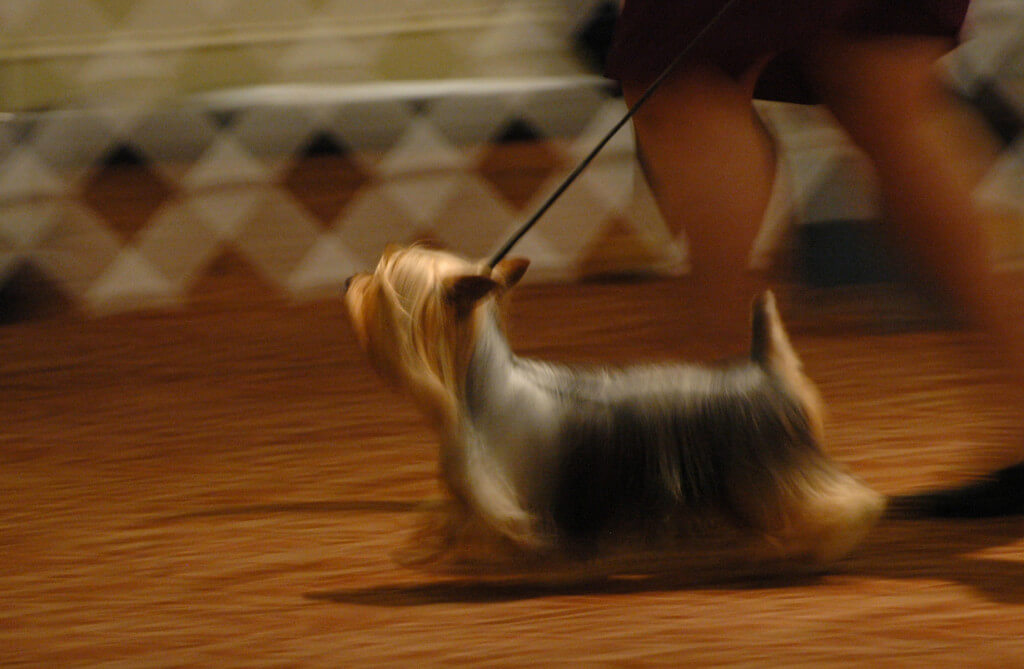Leash Training For Dummies

Harry here LOVES his walkies.
Leash training small dogs can almost seem too easy. Maybe that’s what can make it hard!
We’ve all seen it — a small dog pulling her owner pell mell down the street. Or a small dog hunkered down on the ground, unwilling to move a step despite bribes and tears.
This can give walking small dogs a bad rap. It’s true that small dogs are easy to pick up. So? Wouldn’t it be great to see lots of carefree small dogs sauntering confidently down the road at the side of their owners?
Equipment:
Leash training requires first of all a good leash . Flexis (a plastic handle with a long retractable line) are for playing in fields or for my trained boys who love to mark every rock along our walk. (They know that they have the length of the flexi — and no longer — to lift their leg along the way.)
But for proper leash training, you need a 4 to 6 food leash, no longer.
Above all you will need a good walking collar for proper leash training. I use a parachute choke, 3/8 width seen below:

A choke teaches a dog not when it constricts, but when it releases. So a good choke collar needs to release easily. A parachute choke is made of nylon, not chain, so it slides like silk. It is wide and round and soft so it definitely will not pinch or choke your dog. I recently bought a whole bunch of them on sale at www.dog.com. Sometimes they are called other things but they always look and act the same.
If your dog is refusing to walk, this is what to do:
Put a comfy chair in your yard, with a good book. Put your dog on a long leash. You can tie two leashes together. Put your dog down, tell her “let’s go” and walk over to your chair which is at about the length of the double leash. Settle into your chair and open to the first page. Your dog will watch you resentfully from the other end of the leash, then eventually decide it’s more fun next to you. When she comes, tell her she is magnificent, wonderful, the best dog ever. Don’t do this more than twice the first session.
A general rule of thumb is that dogs do best with short, frequent training sessions.Sometimes your dog will steadfastly refuse to do what you ask. That’s fine. Take her inside and try again tomorrow. Above all don’t rant and rave. I have often had dogs absolutely refuse their lesson for several days, then suddenly do it like a champ.
Once your dog is coming to your chair, carry her about 100 yards up the road from the house. Put her down and tell her, “let’s go.” Dogs like to go home, so this will encourage her to go with you. As she gets good at this, take her farther away. Then walk her away as well as back home.
An interesting note here. I have often seen that some dogs, usually ones that are a bit timid, are happy enough at the start of a walk, but become less and less confident as they go along.
They have seen something along the way that concerns them. So if I see dog observe something and say to themselves, what the heck is THAT, I slow down and even stop, letting them discover for themselves that whatever it is, it will not hurt them.
For dogs who take off at a dead run:
Your dog is not a sled dog. Putting your dog in a harness because “she pulls” is silly, because a harness teaches a dog to pull. Do you want your dog to pull more, or less? You need the same equipment as above, the only thing extra is a good pair of sneakers.
Put the choke high on your dog’s neck, you’ll have better control that way. Take your dog to the middle of a quiet street. Put her down and go.
This is not a saunter. You want to go fast enough get your dynamo’s attention. Pulling dogs often want to pull, then check something out. Pull. Stop. Pull. Stop.
No, you just want to go. You might even need to jog. As you go, your dog’s desire to weave and yank will diminish as she finds she needs all her concentration to keep on burning up the pavement with you.
As she starts going straight, you can slow down. Your leash training has gotten her attention – and she has learned that you can go fast just like her!
A dog that pulls is usually not getting enough exercise. So realize that your small dog will need more and longer walks than most others. I have had several “puller” show dogs. I would usually walk them a couple of miles before going in the ring.
Don’t groan; walking is good for you!